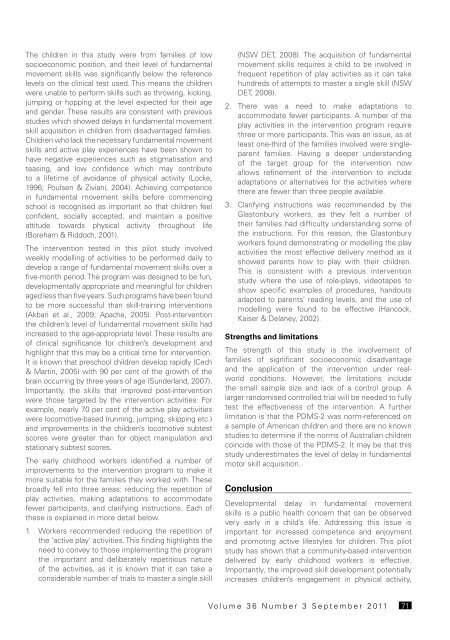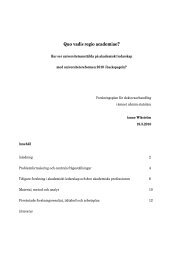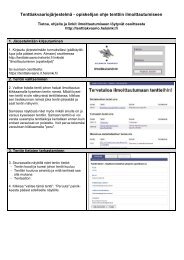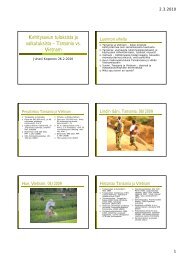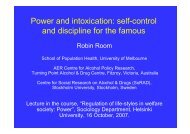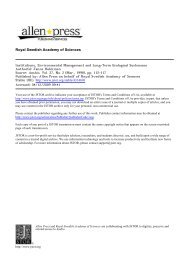Child participant characteristics and motor skillsThe characteristics <strong>of</strong> the participants (n = 26)are presented in Table 2. The sample was <strong>of</strong> lowsocioeconomic status. The following table, Table 3,summarises the baseline standard PDMS-2 scores.At baseline (pre-intervention), the children’s PDMS-2scores were significantly below the PDMS-2 norms inthe locomotion and object manipulation subtests and forthe gross motor quotient scores (p < 0.05). The boys’PDMS-2 scores were also found to be significantly belowthe PDMS-2 norms. At follow-up (post-intervention), therewas a significant difference for the overall Gross MotorQuotient (GMQ; p = 0.007), locomotion (p = 0.009) andobject manipulation (p = 0.035) improvements. Therewas no significant increase found for stationary skills.Although not shown here, there were no significantassociations between the PDMS-2 scores and the child’sage, confirming that the test is age-standardised in thispopulation. Over the course <strong>of</strong> the 22-week intervention,10 children dropped out <strong>of</strong> the study. Of these, onechild refused to participate and nine left the study owingto unrelated issues (see Figure 1 for a breakdown <strong>of</strong>reasons for leaving the study). The reduction in numbersfrom baseline to follow-up was not related to theintervention program.Focus group results with worker participantsTwo themes emerged from the focus group discussion.The main theme was the acceptability <strong>of</strong> the APPactivities in the intervention program and adaptationsrequired to better suit the PLAY program and theGlastonbury clients in the future. Despite the need foradaptations, the intervention program was acceptableto the staff, and the most successful activities werethose that introduced classic outdoor play (for examplequoits, skittles, hula hoops). Examples <strong>of</strong> commentsmade by staff are below:I think [active play activities] fit very well into thebroader scheme <strong>of</strong> things. I think the parents wereused to having five activities and they just handledthat extra activity quite well.I think [active play activities] fitted into the program,really quite well and in a lot <strong>of</strong> ways the activitywas designed to fit into the rest <strong>of</strong> the flow <strong>of</strong> theactivities, the program was, so … I think that wasreally quite well done.… setting up the bowling, some <strong>of</strong> the kids justhadn’t done bowling before and they were justbeside themselves. They just loved it ... evenskipping ropes. How much fun did they have withthose?Staff reported that equipment and space were generallynot a concern. Comments were made such as:… if there wasn’t enough room [inside] you’d moveoutside into the yard or a joining area … [and] ifthey didn’t have skittles we’d ask them to get someempty milk cartons or s<strong>of</strong>t drink bottles.The second theme was related to the characteristics<strong>of</strong> the families who participated in the program. Staffidentified that some <strong>of</strong> the APP activities requiredadaptations to better suit the PLAY program, includingmore variety, simpler instructions, and adaptationfor suitability for only two players. The families’characteristics were related to why particular activitieswere thought to have worked well or requiredadaptation. The characteristics discussed were parent’slimited literacy skills and education; the presence <strong>of</strong>many single-parent families; that the families <strong>of</strong>tendon’t feel obliged or motivated enough to completethe active play activities; that the families did notunderstand that fundamental movement skill (FMS)activities require repetition; and that modelling wassometimes required to show parents how to play withtheir children. Examples include:… some <strong>of</strong> [the active play activities] were a bit toorepetitive … because you felt like you were doingthe kangaroo jumping and that sort <strong>of</strong> thing, somany times.I think in some cases the way that [the active playactivity] was written up was quite comprehensiveand perhaps beyond some <strong>of</strong> our families, sowithout us going through and saying, you know,this is what you do, I don’t think they would actuallysit and actually read the instructions and be able t<strong>of</strong>ollow them.I think … that we need to keep in mind that a lot<strong>of</strong> the times in the families it’s just the motherand the child or the father and the child so to havesomething where you’re … like playing the game‘Duck, Duck, Goose’ where you need more thantwo people to play it’s really not appropriate for ourfamilies.DiscussionThis mixed-methods pilot study has shown that childrenfrom disadvantaged families have delays in theirdevelopment <strong>of</strong> gross motor skills. Despite this, anintervention targeting object manipulation, locomotionand stationary skills significantly improved the children’sskill level. Further, the incorporation <strong>of</strong> the APP activitiesinto the Glastonbury child development and parentingPLAY program was feasible and acceptable to the earlychildhood workers implementing the program. Valuablefeedback was also gained on ways to improve theintervention for use with this group and also inform theuse <strong>of</strong> the program in other children’s settings.70A u s t r a l a s i a n J o u r n a l o f E a r l y C h i l d h o o d
The children in this study were from families <strong>of</strong> lowsocioeconomic position, and their level <strong>of</strong> fundamentalmovement skills was significantly below the referencelevels on the clinical test used. This means the childrenwere unable to perform skills such as throwing, kicking,jumping or hopping at the level expected for their ageand gender. These results are consistent with previousstudies which showed delays in fundamental movementskill acquisition in children from disadvantaged families.Children who lack the necessary fundamental movementskills and active play experiences have been shown tohave negative experiences such as stigmatisation andteasing, and low confidence which may contributeto a lifetime <strong>of</strong> avoidance <strong>of</strong> physical activity (Locke,1996; Poulsen & Ziviani, 2004). Achieving competencein fundamental movement skills before commencingschool is recognised as important so that children feelconfident, socially accepted, and maintain a positiveattitude towards physical activity throughout life(Boreham & Riddoch, 2001).The intervention tested in this pilot study involvedweekly modelling <strong>of</strong> activities to be performed daily todevelop a range <strong>of</strong> fundamental movement skills over afive-month period. The program was designed to be fun,developmentally appropriate and meaningful for childrenaged less than five years. Such programs have been foundto be more successful than skill-training interventions(Akbari et al., 2009; Apache, 2005). Post-interventionthe children’s level <strong>of</strong> fundamental movement skills hadincreased to the age-appropriate level. These results are<strong>of</strong> clinical significance for children’s development andhighlight that this may be a critical time for intervention.It is known that preschool children develop rapidly (Cech& Martin, 2005) with 90 per cent <strong>of</strong> the growth <strong>of</strong> thebrain occurring by three years <strong>of</strong> age (Sunderland, 2007).Importantly, the skills that improved post-interventionwere those targeted by the intervention activities. Forexample, nearly 70 per cent <strong>of</strong> the active play activitieswere locomotive-based (running, jumping, skipping etc.)and improvements in the children’s locomotive subtestscores were greater than for object manipulation andstationary subtest scores.The early childhood workers identified a number <strong>of</strong>improvements to the intervention program to make itmore suitable for the families they worked with. Thesebroadly fell into three areas: reducing the repetition <strong>of</strong>play activities, making adaptations to accommodatefewer participants, and clarifying instructions. Each <strong>of</strong>these is explained in more detail below.1. Workers recommended reducing the repetition <strong>of</strong>the ‘active play’ activities. This finding highlights theneed to convey to those implementing the programthe important and deliberately repetitious nature<strong>of</strong> the activities, as it is known that it can take aconsiderable number <strong>of</strong> trials to master a single skill(NSW DET, 2008). The acquisition <strong>of</strong> fundamentalmovement skills requires a child to be involved infrequent repetition <strong>of</strong> play activities as it can takehundreds <strong>of</strong> attempts to master a single skill (NSWDET, 2008).2. There was a need to make adaptations toaccommodate fewer participants. A number <strong>of</strong> theplay activities in the intervention program requirethree or more participants. This was an issue, as atleast one-third <strong>of</strong> the families involved were singleparentfamilies. Having a deeper understanding<strong>of</strong> the target group for the intervention nowallows refinement <strong>of</strong> the intervention to includeadaptations or alternatives for the activities wherethere are fewer than three people available.3. Clarifying instructions was recommended by theGlastonbury workers, as they felt a number <strong>of</strong>their families had difficulty understanding some <strong>of</strong>the instructions. For this reason, the Glastonburyworkers found demonstrating or modelling the playactivities the most effective delivery method as itshowed parents how to play with their children.This is consistent with a previous interventionstudy where the use <strong>of</strong> role-plays, videotapes toshow specific examples <strong>of</strong> procedures, handoutsadapted to parents’ reading levels, and the use <strong>of</strong>modelling were found to be effective (Hancock,Kaiser & Delaney, 2002).Strengths and limitationsThe strength <strong>of</strong> this study is the involvement <strong>of</strong>families <strong>of</strong> significant socioeconomic disadvantageand the application <strong>of</strong> the intervention under realworldconditions. However, the limitations includethe small sample size and lack <strong>of</strong> a control group. Alarger randomised controlled trial will be needed to fullytest the effectiveness <strong>of</strong> the intervention. A furtherlimitation is that the PDMS-2 was norm-referenced ona sample <strong>of</strong> American children and there are no knownstudies to determine if the norms <strong>of</strong> Australian childrencoincide with those <strong>of</strong> the PDMS-2. It may be that thisstudy underestimates the level <strong>of</strong> delay in fundamentalmotor skill acquisition.ConclusionDevelopmental delay in fundamental movementskills is a public health concern that can be observedvery early in a child’s life. Addressing this issue isimportant for increased competence and enjoymentand promoting active lifestyles for children. This pilotstudy has shown that a community-based interventiondelivered by early childhood workers is effective.Importantly, the improved skill development potentiallyincreases children’s engagement in physical activity,Vo l u m e 3 6 N u m b e r 3 S e p t e m b e r 2 011 71
- Page 3 and 4:
1.5 Display, download or print the
- Page 5 and 6:
Volume 36 Number 3 September 2011Jo
- Page 7 and 8:
Curriculum guidelines for early lit
- Page 9 and 10:
■■Know that print carries meani
- Page 14 and 15:
Korean children’s cultural adjust
- Page 16 and 17:
The Early Years Learning Framework
- Page 18:
Kyung Min said listening in class w
- Page 21 and 22:
immediately impact on children’s
- Page 23 and 24: Child participation in the early ye
- Page 25 and 26: their kindergarten day. A study by
- Page 27 and 28: the overall organisation, routines,
- Page 29 and 30: Council of Australian Governments (
- Page 31: Learning to measure length in the f
- Page 34 and 35: ■■a 40-minute, one-on-one inter
- Page 36 and 37: ■■72 per cent of the project sc
- Page 38 and 39: In other words, the difficulties th
- Page 40 and 41: An analysis of New Zealand’s chan
- Page 42 and 43: Before five also gave equivalent st
- Page 44 and 45: some evidence that curriculum effec
- Page 46 and 47: achievement; aiding transition to s
- Page 49 and 50: ‘It’s a mystery!’A case study
- Page 51: analysis of discourse the children
- Page 56 and 57: ange of objects on the floor (such
- Page 58 and 59: Observation and recording informati
- Page 60 and 61: ‘I’m making it different to the
- Page 62 and 63: Purpose and theoretical frameworkIn
- Page 64 and 65: The fingers were reaching out acros
- Page 66 and 67: Figure 7. ‘I take this lovely lad
- Page 68 and 69: Here, Rachel used substitution to r
- Page 70: Evaluating the feasibility, effecti
- Page 73: Table 2. Descriptive characteristic
- Page 77 and 78: Vol. 36 No. 3 September 2011Austral
- Page 79 and 80: implement the curriculum effectivel
- Page 81 and 82: Table 2. Mean differences between H
- Page 83 and 84: can be regarded as one of the infor
- Page 85 and 86: Ganser, T. (2000). An ambitious vis
- Page 87 and 88: (Buckhalt et al., 2009). Reduced qu
- Page 89 and 90: invited families having difficulty
- Page 91 and 92: Table 3. Mean hours of mother and f
- Page 93 and 94: A reduction in night wakings might
- Page 95 and 96: A preliminary exploration of childr
- Page 97 and 98: adult support necessary for its eff
- Page 99 and 100: Children’s cortisol and alpha-amy
- Page 102 and 103: Connor, C., Son, S.-H., Hindman, A.
- Page 104 and 105: Equity of access:Requirements of In
- Page 106 and 107: excursions, which have been reporte
- Page 108 and 109: We need a bus but we also need a st
- Page 110 and 111: Appropriate child careIndigenous fa
- Page 112 and 113: Australian Institute of Health and
- Page 114 and 115: The Mosaic Approach relies on child
- Page 116 and 117: participants (Altrichter, Posch, &
- Page 118 and 119: distance. This involved trying to b
- Page 120 and 121: Dockett, S., & Perry, B. (2003). Ch
- Page 122 and 123: experiences (Bandura, 1997). Belief
- Page 124 and 125:
the curriculum while on their profe
- Page 126 and 127:
Exploring and evaluating levels of
- Page 128 and 129:
Level 2: Attending to feelingsThis
- Page 130 and 131:
This process to ensure coder stabil
- Page 132 and 133:
DiscussionStructured reflective pro
- Page 134 and 135:
Rock, T. C., & Levin, B. B. (2002).
- Page 136 and 137:
issues encountered in their caring
- Page 138 and 139:
pertaining to the impact and suppor
- Page 140 and 141:
Parents felt the policies involving
- Page 142 and 143:
and access suitable carers because
- Page 144 and 145:
Ievers, C. E., & Drotar, D. (1996).
- Page 146:
www.earlychildhoodaustralia.org.auE


